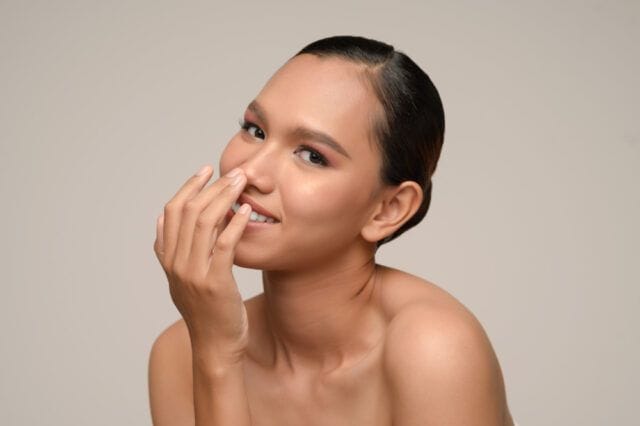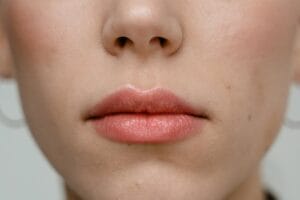Nasal Polyps After Rhinoplasty: What You Need to Know
So you’ve had your rhinoplasty done—maybe three months ago, maybe longer. You were finally breathing better, feeling confident about your new nose, and then… wait. That familiar stuffy feeling is creeping back. Your breathing isn’t what it used to be, and you’re wondering if something’s growing inside your nose again.
Sound familiar? If you’ve dealt with nasal polyps before, or if you’re discovering them for the first time after your nose job, you’re definitely not alone. This is actually one of the trickier complications that can pop up after rhinoplasty, and it’s worth understanding what’s happening and what you can do about it.
What Exactly Are Nasal Polyps?
Think of nasal polyps like little grape-like growths that decide to take up residence in your nasal passages or sinuses. They’re soft, painless, and thankfully noncancerous, but boy, can they make life difficult. Imagine trying to breathe through a straw that keeps getting smaller—that’s kind of what it feels like.
These guys develop when the lining of your nose and sinuses gets chronically inflamed. Your body’s response to this ongoing irritation? It starts producing more cells, which eventually form these teardrop-shaped growths. Some are tiny—you’d barely notice them. Others? They can completely block your nasal passages.
Here’s the thing: unlike polyps you might find elsewhere in your body, nasal ones don’t typically turn cancerous. That’s the good news. The bad news? They can rob you of your sense of smell, cause chronic sinus infections, and make breathing feel like an Olympic sport.
The Rhinoplasty-Polyp Connection
This relationship is… complicated. It works both ways, and honestly, it can be pretty frustrating for patients.
Some people discover they have polyps during the planning phase of their rhinoplasty. Others develop them (or see them come back) after the surgery. I’ve seen patients who never had a polyp in their life suddenly dealing with them post-rhinoplasty—it’s like their nose decided to throw a curveball nobody saw coming.
If You Had Polyps Before Surgery
When polyps are already hanging around before your rhinoplasty, your surgeon has some decisions to make. They could remove them during the nose job, treat them separately, or manage them with medication first.
Many surgeons lean toward handling both issues at once—why go through two separate surgeries when you can address everything in one go? It makes sense from an efficiency standpoint, but it does make the surgery more complex. Think of it like remodeling your kitchen and fixing the plumbing at the same time—possible, but it requires more planning and skill.
The Surprise Discovery
Here’s where things get interesting. Sometimes polyps hide during CT scans and physical exams, only revealing themselves when the surgeon actually opens up your nose during the procedure. It’s like finding a hidden room in your house during renovations.
When this happens, surgeons typically remove what they can without messing up the rhinoplasty plan. But if they find extensive polyposis (fancy word for “lots of polyps”), they might finish the rhinoplasty and recommend tackling the polyps separately later.
Polyps Showing Up After Surgery
This is the scenario that really gets people frustrated. You’ve never had polyps before, you get your rhinoplasty done, and suddenly—bam—polyps appear. Or maybe you had them removed before or during surgery, and they decide to come back with a vengeance.
Surgery creates inflammation, and for some people, that inflammation is like ringing the dinner bell for polyp formation. It’s not super common for first-time polyp patients, but if you’ve dealt with them before, the recurrence rate is unfortunately pretty high.
Who’s Most at Risk?
Understanding your risk factors helps predict whether you might face polyp complications after rhinoplasty.
Chronic Sinusitis: The Big One
If you’ve been dealing with recurring sinus infections or chronic nasal congestion for years, your risk is substantially higher. It’s like having a garden where the soil is always waterlogged—things are just going to grow where you don’t want them.
This creates a nasty cycle: polyps block your sinuses, which prevents proper drainage, leading to more infections and inflammation, which encourages more polyp growth. Breaking this cycle requires addressing both the inflammation and the polyps themselves.
Samter’s Triad (Aspirin Sensitivity)
Some people have this condition called aspirin-exacerbated respiratory disease, or Samter’s triad. It’s like the trifecta nobody wants: asthma, aspirin sensitivity, and nasal polyps with chronic sinusitis.
If you have this condition, polyps tend to be more aggressive and more likely to come back quickly after removal. It’s definitely something to discuss with your surgeon before rhinoplasty—they’ll want to coordinate with your allergist or pulmonologist.
Allergies and Cystic Fibrosis
Allergies can contribute to polyp formation, though the connection isn’t as strong as once thought. Managing your allergies before and after rhinoplasty just makes sense—it reduces inflammation and might help prevent polyp recurrence.
Cystic fibrosis is another story entirely. Nearly all adults with CF develop nasal polyps, and they tend to come back quickly after removal. If you have CF and want rhinoplasty, you’ll need a coordinated team approach involving your CF specialist, rhinoplasty surgeon, and an ENT who specializes in sinus disease.
Spotting the Signs Early
After rhinoplasty, telling the difference between normal healing and polyp development can be tricky. Here’s what to watch for:
Breathing Getting Worse, Not Better
Some congestion is totally normal after rhinoplasty—your nose has been through a lot. But this should gradually improve as swelling goes down. If you notice your breathing getting worse weeks or months after surgery, especially if it was improving before, that’s a red flag.
Polyp-related obstruction usually affects both sides (though not always equally), and it feels different from swelling. Instead of inflammation narrowing your passages, it’s more like something physical is blocking them.
Losing Your Sense of Smell
Rhinoplasty can temporarily mess with your smell due to swelling and nasal packing. Most people get their smell back within weeks to months. But if you lose it completely and it doesn’t come back after three to six months, or if it comes back and then disappears again, polyps might be the culprit.
Polyps physically block odor molecules from reaching your smell receptors. As they grow, your sense of smell gets progressively worse—different from swelling-related smell loss, which tends to fluctuate.
Facial Pressure That Won’t Quit
While polyps themselves don’t hurt, the sinus obstruction they cause can create serious facial pressure or pain. You might feel fullness around your eyes, across your cheeks, or in your forehead.
The key here is timing. Surgical pain and pressure should decrease over time. Polyp-related pressure appears or gets worse as polyps develop, often weeks to months after surgery when other healing has progressed.
That Annoying Post-Nasal Drip
Polyps mess with normal mucus clearance, leading to mucus buildup and drainage. You might notice thick mucus draining down your throat, especially when you lie down or first thing in the morning.
Some post-nasal drip is normal during rhinoplasty healing, but it should resolve within weeks. If it persists or gets worse, especially if it’s thick or discolored, it’s worth getting checked out.
Getting Diagnosed
If you suspect polyps after rhinoplasty, your doctor will likely use a few different approaches to confirm what’s going on.
Nasal Endoscopy: The Gold Standard
This is the most direct way to see what’s happening inside your nose. A thin, flexible scope with a camera gets inserted into your nostril, giving your doctor a clear view of your nasal passages and any polyps present.
It’s not the most comfortable procedure, but it’s usually not painful. The upside? You get immediate, clear information about what’s going on. After rhinoplasty, doctors need to be careful not to disrupt healing tissues, but in experienced hands, it’s safe even relatively soon after surgery if symptoms warrant investigation.
CT Scans: The Big Picture
Computed tomography imaging shows the full extent of sinus disease and polyp involvement. A CT scan reveals polyps within the sinuses that might not be visible on endoscopy, helps assess sinus anatomy, and can identify other issues like bone thickening or sinus opacification.
After rhinoplasty, CT scans also help surgeons see how your nasal structures are healing and make sure no surgical complications are mimicking polyp symptoms.
Allergy Testing: Finding the Root Cause
If polyps are confirmed, allergy testing helps identify potential triggers. Addressing allergic inflammation might reduce your risk of polyp recurrence and improve long-term outcomes.
Treatment Options: What Actually Works
Managing nasal polyps after rhinoplasty requires balancing effective treatment with protecting your rhinoplasty results. Here’s what’s available:
Medical Management: Usually the First Line
For most people, medical therapy is where treatment starts. It avoids additional surgery and can effectively control polyps in many patients.
Nasal Steroid Sprays
These are the foundation of polyp management. Sprays like fluticasone, mometasone, or budesonide reduce nasal inflammation directly. Used consistently, they can shrink existing small polyps and prevent new ones from forming.
You might worry that nasal sprays could mess with your rhinoplasty results. When used correctly—spraying away from the septum and toward the lateral nasal wall—modern sprays don’t damage rhinoplasty structures or cause complications.
Oral Steroids
For larger polyps or more severe symptoms, short courses of oral steroids like prednisone can dramatically shrink polyps. The effect is often temporary (polyps tend to come back after you stop), but oral steroids can provide relief while other treatments kick in.
Long-term oral steroid use isn’t great due to side effects, but short courses (one to two weeks) can be used periodically as needed.
Biologic Medications
This is where things get exciting. Newer treatments like dupilumab (Dupixent) target specific inflammatory pathways involved in polyp formation. These injectable medications can significantly reduce polyp size and prevent recurrence in patients with chronic rhinosinusitis with nasal polyposis.
Biologics are a game-changer for patients with severe, recurrent polyps. They’re expensive, but they offer an alternative to repeated surgeries for the right candidates.
Leukotriene Modifiers
Medications like montelukast (Singulair) block inflammatory pathways and may help some patients, particularly those with aspirin sensitivity or asthma. The effect on polyps is modest compared to steroids, but these medications have a good safety profile for long-term use.
When Surgery Becomes Necessary
When medical management isn’t cutting it, surgical removal becomes the next step. After rhinoplasty, this decision requires careful consideration.
Timing Matters
Most surgeons recommend waiting at least six to twelve months after rhinoplasty before performing sinus surgery for polyp removal. This allows complete rhinoplasty healing and minimizes risk to your aesthetic results.
If polyps are causing severe symptoms earlier, surgery might be necessary sooner, but the risks and benefits need to be weighed carefully.
Endoscopic Sinus Surgery
This minimally invasive approach uses endoscopes to remove polyps and open blocked sinus passages. The surgery typically preserves external nasal structures, so it shouldn’t affect your rhinoplasty results.
The goal is thorough polyp removal and enlarging natural sinus openings to improve drainage and reduce recurrence. Most patients go home the same day, though recovery takes several weeks.
Protecting Your Rhinoplasty Results
This is crucial. Surgeons performing sinus surgery after rhinoplasty must be extremely careful. They need to remove polyps thoroughly while avoiding structures modified during rhinoplasty, particularly septal cartilage used for grafts or areas of tip refinement.
This is why choosing an experienced ENT or rhinologist familiar with post-rhinoplasty anatomy is so important. They understand the altered anatomy and know how to navigate safely.
The Best Approach: Combining Treatments
The most effective strategy often combines medical and surgical treatment. Surgery removes existing polyps, while ongoing medical management—typically nasal steroid sprays, possibly with biologics—prevents or delays recurrence.
This approach acknowledges that nasal polyps are a chronic condition. Surgery provides relief, but long-term control requires continued medical therapy. Think of it like managing diabetes or high blood pressure—it’s an ongoing commitment, not a one-and-done fix.
Preventing Recurrence: The Long Game
Whether you’ve had polyps removed before, during, or after rhinoplasty, preventing recurrence is crucial for maintaining both nasal function and your rhinoplasty results.
Stay Consistent with Medical Therapy
This is the big one. Nasal steroid sprays only work if you use them daily, even when you feel fine. Skipping doses or stopping treatment when symptoms improve almost guarantees polyp return. I can’t emphasize this enough—consistency is everything.
Manage Those Underlying Conditions
Addressing conditions that promote inflammation reduces your polyp risk. This means:
- Controlling allergies with antihistamines, immunotherapy, or allergen avoidance
- Managing asthma with appropriate medications
- Treating chronic sinus infections promptly
- Avoiding aspirin and NSAIDs if you have aspirin sensitivity
Each of these interventions reduces the inflammatory burden on your nasal passages, creating an environment less conducive to polyp formation.
Keep Up with Sinus Irrigation
Regular nasal irrigation with saline helps clear mucus, reduce inflammation, and wash away irritants. Many rhinoplasty surgeons recommend sinus irrigation during recovery anyway, so continuing this practice long-term serves double duty—supporting rhinoplasty healing and reducing polyp risk.
Just use distilled, sterile, or previously boiled water for irrigation, never tap water, to avoid rare but serious infections.
Don’t Skip Follow-Ups
Regular follow-up with your surgeon or ENT specialist allows early detection of recurring polyps. Small polyps caught early often respond to increased medical therapy, avoiding the need for repeat surgery.
Don’t wait until symptoms become severe to seek evaluation. If you have a history of polyps and notice any concerning symptoms after rhinoplasty, get checked promptly.
When to Combine Rhinoplasty and Polyp Removal
Some patients need both rhinoplasty and nasal polyp removal. Whether these can or should be combined in a single surgery depends on multiple factors.
The Benefits of Doing Both Together
Performing both procedures simultaneously means one anesthesia exposure, one recovery period, and potentially lower overall cost. If you need functional rhinoplasty for breathing issues and also have polyps, addressing both together makes logical sense.
Also, removing polyps provides better access to nasal structures, potentially allowing more precise rhinoplasty modifications.
The Challenges
Combined surgery is more complex and takes longer, which increases anesthesia time and potential complications. The extensive manipulation required for thorough polyp removal may increase swelling and prolong recovery compared to rhinoplasty alone.
There’s also the concern that polyp recurrence might necessitate future sinus surgery, which could potentially affect rhinoplasty results. Some surgeons prefer to establish good polyp control medically or with isolated sinus surgery before performing rhinoplasty, ensuring a stable baseline.
Making the Decision
The choice to combine procedures should involve detailed discussion with your surgeon. Factors to consider include:
- Severity and extent of polyps
- Whether rhinoplasty is primarily cosmetic or functional
- Your overall health and ability to tolerate longer surgery
- Likelihood of polyp recurrence based on your history
- Your surgeon’s experience with combined procedures
There’s no universal right answer—the decision must be individualized to your specific situation.
When to Pick Up the Phone
Certain symptoms after rhinoplasty warrant prompt evaluation, whether or not you have a polyp history:
Progressive breathing difficulty that worsens rather than improves after the first few weeks should be assessed. This could indicate polyps, but it might also signal other complications like scar tissue formation or septal issues.
Complete loss of smell persisting beyond three months, or smell that returns then disappears, raises concern for polyps or other problems requiring evaluation.
Severe facial pain or pressure, particularly if accompanied by fever or colored nasal discharge, might indicate sinus infection, which can be related to polyps.
Visible masses in your nostril, especially if growing or changing, should be evaluated promptly. While likely polyps, any visible growth warrants examination.
Living with Both: Polyps and Your New Nose
Managing nasal polyps after rhinoplasty can feel frustrating, especially if you underwent nose surgery to improve breathing only to have polyps compromise those gains. But here’s the thing—with appropriate treatment and realistic expectations, most patients achieve good long-term outcomes.
Understanding that nasal polyps represent a chronic condition helps frame expectations appropriately. They may require ongoing management, but that management can be effective in controlling symptoms and preventing significant recurrence.
Your rhinoplasty results don’t have to be compromised by polyps. With careful surgical technique, appropriate medical management, and vigilant follow-up, you can maintain both the aesthetic and functional benefits of your rhinoplasty while effectively managing polyp disease.
The key is partnership with knowledgeable physicians who understand both rhinoplasty and sinus disease. Whether that’s a single surgeon with dual expertise or a team approach involving a rhinoplasty surgeon and a rhinologist, having experts who communicate and coordinate your care ensures the best possible outcome.
Patience is essential here. Polyp management is often a process of finding the right combination of treatments that work for your individual situation. Some trial and error may be involved, but most patients eventually achieve good control and can enjoy both clear breathing and the aesthetic improvements of their rhinoplasty.
At the end of the day, dealing with nasal polyps after rhinoplasty is about finding the right balance—treating the polyps effectively while protecting the results you worked so hard to achieve. It’s not always easy, but it’s definitely doable with the right approach and the right team.














Post Comment